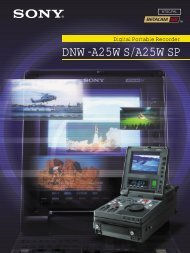1200 Series Professional VHF Wireless Systems - Audio-Technica
1200 Series Professional VHF Wireless Systems - Audio-Technica
1200 Series Professional VHF Wireless Systems - Audio-Technica
You also want an ePaper? Increase the reach of your titles
YUMPU automatically turns print PDFs into web optimized ePapers that Google loves.
System OperationTurn down the AF Level of the receiver as well as the mixer.Switch on the receiver. Do not switch on the transmitter yet.Receiver On…The power indicator will light up and one of the tuner operationindicator LEDs (A or B) will light, even though the transmitter isnot on. If any of the RF LEDs light up at this point, there may beRF interference in the area, or a nearby TV station is on thesame frequency. Check the frequency of the system against thechart on page 7 to ensure you have the proper frequency foryour area. The frequency is marked on the back panel of thereceiver.Transmitter On…When the transmitter is switched on and in normal operation,the receiver’s RF signal level indicators will light up from left toright. For optimum performance at least four, and preferably five,of the signal strength indicators should light up when the transmitteris switched on. The transmitters have a three-positionpower switch. When the switch is set to “Standby,” the transmitterproduces RF with no audio signal. When the switch is“On,” the transmitter produces both RF and audio.For INSTRUMENT: Next, while again playing the instrumentat typically-loud levels, adjust the receiver’s AF Level control sothe highest signal level causes no input overload in the instrumentamplifier, and yet permits the amplifier’s input levelcontrols to operate in their “normal” range (not set too highor too low).NOTE: With some instrument amplifiers, the receiver’s AF Levelcontrol may need to be adjusted to between “0” and “+6” tobetter drive the amplifier.CAUTION! The small trimmer controls are delicate; use only asmall screwdriver or alignment tool with a maximum 3 /32"-wideblade. Do not force the trimmers beyond their normal 210°range of rotation.MicrophoneTrimmer (M)GuitarTrimmer (G)Setting LevelsCorrect adjustment of transmitter audio input, receiver audio output,and mixer/amplifier input and output levels is important foroptimum system performance.• ATW-T35 UniPak TransmitterTrimmer adjustments in the UniPak transmitter (Fig. K) willenable you to use microphones or instruments with differentoutput levels.1. Set both the transmitter Mic Level (M) and Guitar Level (G)controls to their full counter-clockwise position (minimum). (Thelevel control not being used should be set to minimum.)2. Set the receiver’s AF Level control to “0.”3. Plug the mic or instrument into the transmitter and power upthe system.4. For MIC: Make an initial adjustment of the mixer’s levelcontrols that will allow audio through the system as you increasethe transmitter’s Mic Level.For INSTRUMENT: Make an initial adjustment of the instrumentamplifier input level control that will allow audio throughthe system as you increase the transmitter’s Guitar Level.5. For MIC: While speaking/singing into the microphone at typically-loudlevels, turn up the transmitter’s Mic Level (M) controluntil the maximum audio output of the mic lights about three orfour green LED segments on the receiver’s AF Level indicator.For INSTRUMENT: While playing the instrument at typicallyloudlevels, turn up the transmitter’s Guitar Level (G) control untilthe maximum audio output of the instrument lights about threeor four green LED segments on the receiver’s AF Level indicator.NOTE: Do not set the transmitter level too high (as indicatedby lighting of the red LED) – doing so will cause the system tooverload and distort.6. For MIC: Next, while again speaking/singing into themicrophone at typically-loud levels, adjust the mixer’s input trimcontrol so the highest sound pressure level going into the microphonecauses no input overload in the mixer, and yet permitsthe mixer’s channel and output level controls to operate in their“normal” range (not set too high or too low).NOTE: With the receiver’s AF Level control set at “0,” thebalanced output voltage will be similar to that of a typical wiredmicrophone. However, the AF Level control may be adjustedto accommodate some microphone inputs – for example, thosewith limited-range or no input trim controls.Fig. K• ATW-T36HE and ATW-T37C Handheld TransmittersThe <strong>1200</strong> <strong>Series</strong> handheld transmitters have factory pre-setaudio input levels.1. Set the receiver’s AF Level control to “0.”2. Turn the transmitter on and power up the system.3. Turn down the mixer’s input trim control (if provided) onthe selected channel; make an initial adjustment of the mixerchannel and output level controls that will allow audio throughthe system.4. While speaking/singing into the microphone at typically-loudlevels, adjust the mixer’s input trim control so the highest soundpressure level going into the microphone causes no input overloadin the mixer, and yet permits the mixer’s level controls tooperate in their “normal” range (not set too high or too low).NOTE: With the receiver’s AF Level set at “0,” its balanced outputvoltage will be similar to that of a typical wired microphone.However, the AF Level may need to be adjusted to accommodatesome microphone inputs.Receiver SquelchThe squelch control on the back panel of the receiver is presetat the factory, but can be adjusted if you must use the systemin an area with considerable RF interference. If there isinterference in the receiver's audio, adjust the squelch control sothe system will receive the signal from your transmitter but will“squelch” or eliminate the unwanted background RF noise. Thisadjustment can cause a reduction in useable range of the wirelesstransmitter, so set the control to the lowest position thatreliably mutes the unwanted RF signals.5
















